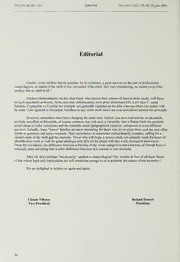
Preview Editorial
. VlLVENS&HOUAM Editorial NoVAPEX 2 (2): 29-30, 20juin 2001 Editorial Clearly, every mollusc familyjustifies, by its existence, a great interest on the part ofprofessional malacologists, no matter ifthe shell is tiny, no matter ifthe color isn't very shimmering, no mattereven ifthe mollusc has no shell at ail ! Amateur malacologists, on the otherhand, who choose theircenters ofinterest more easily, will focus on such arguments as beauty, form, size and, unfortunately, even price sometimes (©). Let's face it : some families, Cypraeidae orConidae forexample, are generally regarded as the élite whereas others (no names will be made !) are ignored ordiscarded. Needless to say, some shell shows are even articulated around this principle. However, mentalities hâve been changing for some time. Indeed, you now read articles on nassariids, trochids, nucellids or littorinids, ofcourse common, but with such a variability that it flatters both the aesthetic mind (shape orcolorvariations) and the scientific mind (geographical variation, subspecies oreven différent species). Actually, thèse "minor" families are most interesting forthose who try to study them, and are very often fertile in questions and topics research. Their systematics is sometimes extraordinarily complex, calling fora careful study ofthe shell and the anatomy. Those who will begin a serious study are certainly ready forhours of identification work as well forgreat ethologic and, let's not be afraid with this word, ecological discoveries. From this viewpoint, the différence between a littorine ofthe Asian mangroves and a littorine ofFlorida Keys is infinitely more enrichingthan a colordifférence between two cowries ortwo muricids. Afterail, that's perhaps "biodiversity" applied to malacologists? Ourwonder in face ofail thèse forms oflife whose logic and imbrications are still somewhat strange to us is probably the source ofour incentive ! We are delighted to believe so again and again. . Claude Vilvens Roland Houart Vice-Président Président 30
